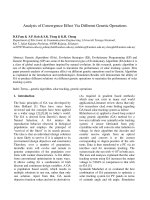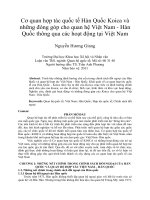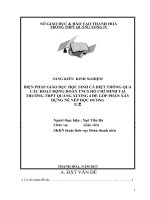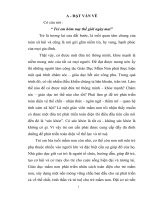Phân tích Effect Hội tụ Thông qua các hoạt động khác nhau di truyền
Bạn đang xem bản rút gọn của tài liệu. Xem và tải ngay bản đầy đủ của tài liệu tại đây (149.21 KB, 9 trang )
Analysis of Convergence Effect Via Different Genetic Operations
D.F.Fam & S.P. Koh & S.K. Tiong & K.H. Chong
Department of Electronic & Communication Engineering, Universiti Tenaga Nasional,
Km 7, Jalan Kajang-Puchong, 43009 Kajang, Selangor.
,,,
Abstract: Genetic Algorithms (GAs), Evolution Strategies (ES), Evolutionary Programming (EP) and
Genetic Programming (GP) are some of the best known types of Evolutionary Algorithm (EA)where it is
a class of global search algorithms inspired by natural evolution. In this research, genetic algorithm is
one of the optimization techniques used to maximize the performance of solar tracking system .This
paper presents analysis of convergence effect via different genetic operations used in Genetic Algorithm
as explained in the introduction and methodologies. Simulation Results will demonstrate the ability of
GA to produce different solutions via different genetic operations to maximize the performance of solar
tracking system.
Index Terms—genetic algorithm, solar tracking, genetic operations
1. Introduction
The basic principles of GA was developed by
John Holland [1] They have since been
reviewed and the concepts have been applied
on a wider range [2],[3],[4] in today’s world.
The GA is derived from Darwin’s theory of
Natural Selection. A GA mimics the
reproduction behavior observed in biological
populations and employs the principal of
“survival of the fittest” in its search process.
The idea is that an individual (design solution)
is more likely to survive if it is adapted to its
environment (design objectives and constraints).
Therefore, over a number of generations,
desirable traits will evolve and remain in
genome composition of the population over
traits with weaker characteristics. A GA differs
from conventional optimization in many ways.
It allows coding for a combination of both
discrete and continuous design variables. A GA
is population based search, which results in
multiple solutions in one run, rather than only
one solution. Apart from that, GA needs
objective function values and not its derivatives
(As required in gradient based methods)
which may not exist in many real world
applications.Literature review shows that only
few researchers cited some finding regarding
GA based solar tracking system as follow:
Khlaichom et al. applied a closed loop control
using genetic algorithm (GA) method for a
two-axis (altitude over azimuth) solar tracking
system. A sensor fabricated from poly
crystalline solar cell converts solar radiation to
voltage. In their algorithm the decoder and
counter receive signals from an optical
encoder and convert it to the current
corresponding to degree-position of the axle
turns. Data is then transferred to a PC via an
interface card for maximum tracking. The
system tracks the sun with +/-10
0
in both axes.
The tests and analyses explained that the solar
tracking system using GA increases the output
voltage to 7.084% in comparison to that with
no GA [5].
Syamsiah Mashohor et al. evaluated the best
combination of GA parameters to optimize a
solar tracking system for PV panels in terms
of azimuth angle and tilt angle. Simulation
results demonstrated the ability of the proposed
GA system to search for optimal panel
positions in term of consistency and
convergence properties. It also has proved the
ability of the GA-Solar to adapt to different
environmental conditions and successfully track
sun positions in finding the maximum power by
precisely orienting the PV panels.[6]
However, recent researches for GA based solar
tracking system are based on the traditional GA
algorithm structure which is shown as below:
// populations //
t=0
Step 1= Initialize P (t)
Evaluate P(t)
While (Solution NOT found OR Max
Generation NOT Reached)
Do
t= t + 1
Select P(t) from P(t-1)
Recombine P(t)
{
Do Crossover
Do Normal Mutation
}
Evaluate P(t)
If
{
P(t) = Solution;
End If
}
End
As shown in the Algorithm above, traditional
genetic algorithms are composed of four key
processing as shown below [7] :
1) initialize P(t)
2) evaluate P(t)
3) select P(t)
4) recombine P(t)
Anyhow, most population-based, reproductive,
optimization algorithms such as genetic
algorithms had a critical problem called
premature convergence problem [8, 9, 10]. This
problem occurs when highly fit parents in a
population pool breed many similar offspring
in the early evolution time. If the highly fit
individuals are local optima areas, then newly
generated offspring from the parents are also
near the local optima areas.
In this coming methodology section, an
explanation of different genetic operations
will be studied and results section will show
the best genetic operations in preventing
premature convergence problem.
2. Methodology
Methodology part is divided into few sub
sections below:
1) Conventional crossover and mutation
2) Crossover only
3) Clone and selective mutation
2.1 Conventional Crossover and Mutation
Using conventional method of having
crossover and mutation in Genetic Algorithm
will affect its performance. One of the typical
problem is Premature Convergence Problem
[11,12].Most individuals in a prematurely
converged situation are located at some local
optimum areas and they can’t get out of the
local optimum areas because the exploration
power of mutation is low. If we increase the
exploration power by setting the mutation
probability to high, then the speed of
convergence to global optimum areas becomes
slow. As a result, it is very difficult for genetic
algorithms to escape this premature
convergence problem. This considerably
makes the performances of genetic algorithms
degrade.
2.2 Crossover Only
Crossover is a genetic operator that combines
two chromosomes (parents) to produce a new
chromosome (offspring). The purpose of
crossover is to produce the new offspring which
is better than both of the parents if it takes the
best characteristics from each of the parents.
Crossover occurs during evolution according to
a user-definable crossover probability. In this
experiment, a single point crossover is used.
Consider the following 2 parents which have
been selected for crossover. The “|” symbol
indicates the randomly chosen crossover point.
Parent 1: 11001|010
Parent 2: 00100|111
After interchanging the parent chromosomes at
the crossover point, the following offspring are
produced:
Offspring1: 11001|111
Offspring2: 00100|010
Crossover can not generate quite different
offspring from their parents because it uses
acquired information from their parents.
2.3 Clone and selective mutation
In most function optimization problems, their
input variables are encoded into the binary
strings of individuals. Since the binary strings
represent binary numbers for each variable, the
higher the bit position of string is, the larger the
bit weight has. From this, it is helpful to mutate
some part of strings of individuals according to
their fitness. That is, if an individual has low
fitness, then we mutate the most significant part
in order to largely change because we regard
the individual to be far from the global
optimum. Otherwise, we mutate the least
significant part in order to do fine tuning
because the individual has high probability to
be near global optimum. This selective
mutation can make genetic algorithms fast
approach to the global optimum and quickly get
out of premature convergence. As a result, it
will increase the performances of genetic
algorithms.
3. Simulation
A solar tracking has been developed to
evaluate the application of genetic algorithm
as depicted in Figure 3. It would explore the
intensity of sunlight at different angles and
locate the highest intensity with the GA
simulation. The solar tracking is placed at the
origin point of (Xo=45 °, Yo=45 °). The
default base point is at the centre of the
workspace. In the simulation, the solar cell
will keep on searching the highest intensity
location with GA searching method. Both
stepper motors controlling X and Y axis of
solar tracking will receive the signals through
motion controller to determine the angles of
movement for both axis. Highest intensity that
is absorbed by solar cell will convert the
digital voltage to analogue signal to be
transmitted to Visual basic program via
Programmable logic controller Panasonic
FPX-C14R.
The simulation has been carried out using the
Conventional GA given in 3 tables below,
Table 1, Table 2 and Table 3 with the
objectives to analyse the convergence effect.
Table 1: Conventional GA simulation
parameter
Simulation Parameter Value
Maximum Generation
Population, p
o
Chromosome length
Selection Method
Crossover Rate, p
c
Mutation Rate, p
m
Mutation Point, m
p
No.BestChromosomes
Kept, k
b
Crossover Type
50
10
8
Roulette Wheel
80%
0.025
2
1
Dynamic
Table 2: Conventional GA simulation
parameter with Crossover Only
Simulation Parameter Value
Maximum Generation
Population, p
o
Chromosome length
Selection Method
Crossover Rate, p
c
No.BestChromosomes
Kept, k
b
Crossover Type
50
10
8
Roulette Wheel
80%
1
Dynamic
Table 3: Conventional GA simulation
parameter with clone and selective mutation
Simulation Parameter Value
Maximum Generation
Population, p
o
Chromosome length
Selection Method
Crossover Rate, p
c
Elitism Rate, E
c
Selective Mutation
No.BestChromosomes
Kept, k
b
Crossover Type
50
10
8
Roulette Wheel
80%
80%
0.025
1
Dynamic
Results of this implementation will be shown in
the section as below.
4. Preliminary Results
This solar tracking has been performed under
on a sunny day around 11am at school field.
From the first simulation parameters
requirement which publish conventional genetic
algorithm characteristic, gathered results will be
shown as graph below:
0 10 20 30 40 50 60 70 80 90 100
0.01
0.02
0.03
0.04
0.05
0.06
0.07
0.08
Generation
Fitness value
Best: 0.018654 Mean: 0.018654
Best fitness
Mean fitness
Graph 1 : Best Fitness Value- 0.018654 using
conventional GA
10 20 30 40 50 60 70 80 90 100
0
0.1
0.2
0.3
0.4
0.5
0.6
0.7
0.8
Generation
Avergae Distance
Average Distance Between Individuals
data1
Graph 2 : Average distance between
individuals in each generation using
conventional GA
0 5 10 15 20 25 30 35 40 45 50
0
1
2
3
4
5
6
7
8
9
10
11
Generation
Individual
crossover children
mutation children
Graph 3 : genealogy of each individual across
the generations using conventional GA
Graph 3 : Best, worst and mean score for each
generation using conventional GA
1 2 3 4 5 6 7 8 9 10
0
0.5
1
1.5
2
2.5
3
3.5
4
Selection Function
Individual
Number of children
state.Selection
Graph 4 : Number of children that is produced
by each individual using conventional GA
0 5 10 15 20 25 30 35 40 45 50
0.01
0.02
0.03
0.04
0.05
0.06
0.07
Generation
Fitness value
Best: 0.018079 Mean: 0.018079
Best fitness
Mean fitness
Graph 5 : Best Fitness Value- 0.018019 using
conventional GA with Crossover only
10 20 30 40 50 60 70 80 90 100
0
0.02
0.04
0.06
0.08
0.1
0.12
0.14
0.16
Generation
Best, Worst, and Mean Scores
Best Score
Median Score
Worst Score









